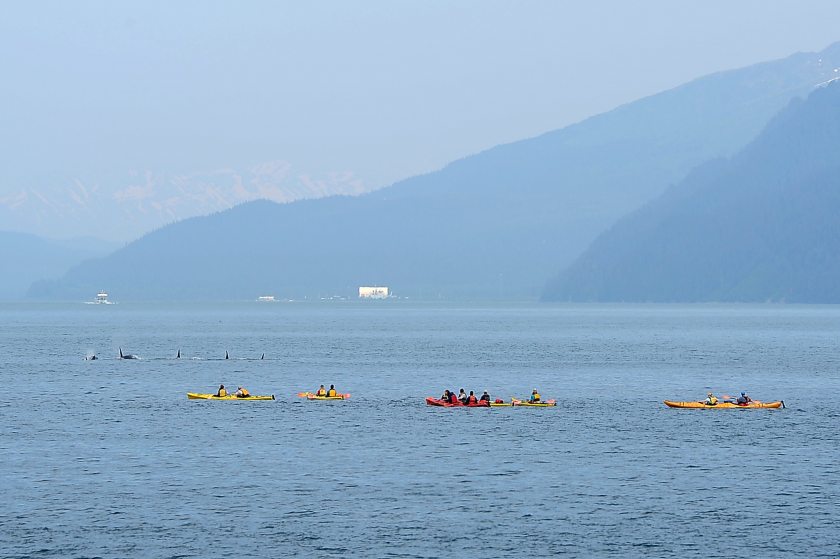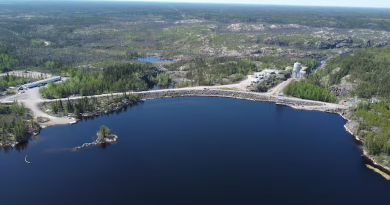Alaska cultural tourism comes with challenges

Several times a week, Cecelia George dresses in the regalia of her Tlingit ancestors to play the coveted role of Raven for cruise ship passengers visiting Hoonah, her village in Southeast Alaska.
Donning a mask and headdress, George, 16, transforms herself into the mythical bird that created all things and brought light, water and language to humankind.
“I love the feeling,” said George, who works for Icy Strait Point, a tourism business owned by Alaska Native corporation Huna Totem. “It’s awesome to come to work everyday and tell visitors about our culture and tell stories and sing songs for them.”
While the performance clearly required many hours of practice, it’s likely that few, if any, of the visitors in the wooden bleachers at the Heritage Center Native Theater are aware of the hard decisions that go into showcasing a living culture for outsiders.
What should and should not be shared with outsiders and who decides?
For Hoonah and other Alaska Native communities, cultural tourism can offer a good source of jobs and revenue. But adding dance performances, cooking demonstrations and historical tours to the fabric of a village economy raises questions not normally faced by hotels or fish-and-chip shops.
How does a community remain true to its cultural norms even if it means disappointing visitors with deeply held beliefs or stereotypes about Alaska Natives? Can it meet the schedules and other demands of a for-profit enterprise while maintaining traditional practices? What should and should not be shared with outsiders and who decides?
Camille Ferguson, former head of Sitka Tours in Southeast Alaska, said many of these decisions rest with the elders. Ferguson, who is Tlingit, said she erred early on in her career when she signed a contract with a cruise ship company to put on a traditional dance performance.
“I had knowledge of contract law, but not tribal law and I didn’t have the knowledge that if a family member passes on, you shouldn’t be dancing,” Ferguson said. “Word got out that people who shouldn’t have been dancing did, and the elders came and talked to me.”
On the elders’ advice, Sitka Tours decided to substitute storytelling for dancing should the situation arise again. When it did, performers instead told the story of the arrival of the Russians and how the inhabitants of Sitka thought the sails of their boats were the White Raven. The guests, Ferguson said, were moved.
Keeping culture alive
Travelers who are eager to learn about local culture and heritage tend to be slightly older, more educated, have higher household incomes and generally spend more money than visitors who do not prioritize culture, according to a study whose sponsors include the U.S. Cultural & Heritage Tourism Marketing Council.
But Ferguson, who is now executive director of the American Indian Alaska Native Tourism Association in Albuquerque, New Mexico, said economics are not the only reason tribes engage in cultural tourism.
“Tribes are looking at it as both as an economic opportunity and way of perpetuating their culture,” she said. “They want to tell their stories and interpret their art and their way of life rather than having anyone else do it.”
In Hoonah, Randy Roberts, 16, who narrates the Raven performance, said he has seen visitors from American Indian reservations in the Lower 48 leave the show crying.
“It’s because their culture is dead and they see our culture is still alive with the young folk. It’s not just the old folk,” he said.
Wary of too much emphasis on culture
And yet, in many cases, shining a spotlight on Alaska Native culture as part of a for-profit enterprise can be too delicate a matter, even for one of the largest Native-owned companies in the tourism industry.
Sophie Minich, president and CEO of the Cook Inlet Regional Corporation, said the company is wary of putting too much of an emphasis on cultural tourism in its for-profit operations because of the unusually broad ancestral diversity of its shareholder base.
The company is one of the most financially successful of the 12 land-based regional corporations established by the Alaska Native Claims Settlement Act of 1971. Because its landholdings are located in Southcentral Alaska, where the state’s commercial and population centers are located, Alaska Natives living in the CIRI region before the act was passed could opt to enroll as CIRI shareholders or shareholders of corporations representing the regions of their forebears.
That makes CIRI the most diverse of all the regional Native corporations, with board members who are Inupiaq, Yup’ik, Athabascan, Tlingit, Haida and Aleut.
“It’s really hard for us to focus in on one culture because we are so diverse,” Minich said. The company also believes that putting too great an emphasis on cultural activities could divert visitors from the Alaska Native Heritage Center, a major cultural nonprofit in the region that CIRI supports.
Instead, CIRI’s tours and lodge properties, from Denali National Park to Fox Island near Seward, highlight Alaska’s wildlife and natural landscape. One company subsidiary, Kenai Fjords Tours, takes passengers on catamaran tours of Resurrection Bay to view orcas, humpback whales, puffins and glaciers. A video with a segment on the history of the region’s Dena’ina people plays on a flatscreen television in a corner of the cabin, but few passengers stop to watch.
Remote communities
Cultural tours and attractions, both for-profit and nonprofit, are available throughout Alaska, according to a list compiled by the state Department of Commerce, Community and Economic Development. The larger, more formalized operations tend to be in Southeast, Southcentral and Fairbanks, places that attract greater numbers of travelers because of easy access to the road system, major air links and the state’s largest cities.
But large swaths of rural Alaska receive few tourists. In those remote areas, communities and companies have fewer opportunities to develop marketing skills or practice interacting with travelers, said Alexis Bunten, Ph.D., an anthropologist and author of “So, How Long Have You Been Native?: Life As an Alaska Native Tour Guide.”
“Indigenous communities in remote places often have a difficult time marketing their destinations and connecting with people who want to visit,” said Bunten, a shareholder of Bristol Bay Native Corp., another of the corporations formed under the settlement act.
Some communities simply don’t want tourists at all.
“Oftentimes in very rural areas, local people are afraid visitors will overrun the community, look through windows or step on their personal space,” said Bunten, who has also worked as a cultural tourism consultant worldwide. “And for those living a subsistence lifestyle, people can’t show up for work sometimes. They have to go hunting or fishing.”
Still, travelers straying far from the state’s well-beaten tourist paths may find opportunities to interact with Alaska Native residents in ways that are less choreographed than places more well-accustomed to visitor traffic.
Importance of cultural control and ownership
LaVonne Hendricks, who runs a fish camp on the Northwest Arctic coast several miles outside Kotzebue, said in recent years about 50 tourists a season have stopped by to learn about subsistence fishing and traditional ways to preserve the catch. Hendricks, who is not Alaska Native, came to Kotzebue from Northern California in 1966 to work as a public health nurse.
“The real reason we are continuing to do anything in cultural tourism is for the local folks to present themselves and their culture in a real positive light,” she said.
The camp, which overlooks the Chukchi Sea, is a working fish camp first and foremost, but also serves as an “informal way to meet people when they’re busy living their lives,” she said.
Visitors can hear presentations about the region and its people, medicinal plants, fish cutting, drying and smoking and cross-cultural communications, or “how to make sure you don’t insult local people,” as Hendricks puts it.
“One of the things you can’t be is act like the know-it-all expert on something, so the local people and I work together,” she said. “I really like them to do the presentations. This is about their culture, not mine.”
That concept of cultural control and ownership is strong in many communities, including Hoonah. Huna Totem, the native corporation that owns and operates Icy Strait Point, had to secure permission from elders to perform certain songs and stories for cruise ship passengers, said Johanna Dybdahl, the company’s cultural supervisor.
Each clan has its own stories and songs that traditionally can be told only by its members. The practice helped preserve the integrity of stories across generations, Dybdahl said.
“Even in this day and age when a lot has been printed and is in the public domain, we still ask permission and don’t do anything unless we get that permission,” Dybdahl said.
They perform the Raven creation story, she said, “because it belongs to everybody.”
Related stories from around the North:
Canada: The environmental and social impacts of Arctic tourism, Eye on the Arctic
Finland: Arctic Finland looks for boost from Chinese tourists, Yle News
Norway: Russia boosts tourism on Svalbard, Norway, Barents Observer
Russia: Currency drama has little impact on tourism in Barents region, Barents Observer
United States: Yurts, tents and urban suites — Airbnb options grow in Alaska, Alaska Dispatch News



